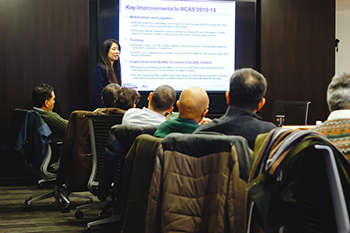Tackling Capital Planning One Problem at a Time
 When school administrations prepare a capital plan, the task is anything but simple. It’s extremely difficult to determine and prioritize the complex needs of aging facilities, especially with tight budgets and processes involving internal and external stakeholders. However, annual school building condition surveys — such as the one overseen by the New York City School Construction Authority (NYSCA) and undertaken by a multinational firm — demonstrate that capital planning can be made easier with a mixture of digital-age tools and thoughtful project management.
When school administrations prepare a capital plan, the task is anything but simple. It’s extremely difficult to determine and prioritize the complex needs of aging facilities, especially with tight budgets and processes involving internal and external stakeholders. However, annual school building condition surveys — such as the one overseen by the New York City School Construction Authority (NYSCA) and undertaken by a multinational firm — demonstrate that capital planning can be made easier with a mixture of digital-age tools and thoughtful project management.
For almost two decades, New York-headquartered engineering professional services consulting firm Parsons Brinckerhoff has performed an annual building condition assessment survey (BCAS) on behalf of NYSCA with consistently successful results. Using digital tablets for on-site recording, inspection teams of trained architects and engineers perform hierarchical, stratified observations that impartially assess building components. The result is a systemically gathered, deficiency-focused report that helps establish capital-planning foundations and future-project scoping from an objective, independent perspective. The teams visit hundreds of schools and provide needs-based information for each one. Eventually, the reports are posted online, creating a digital pubic transparency as well.
Prior to BCAS, it was difficult for the city to justify school capital planning needs totaling more than $1 billion, and the pressure to do more with less presented serious issues. However, with the help of BCAS, funding strategies are now at the point where having several billion dollars allocated for school capital improvements is possible.
Getting Data Right
Accuracy and consistency in field collection data are essential to provide a reliable foundation for capital planning and further building analysis. To maintain accuracy and combat the distractions of fieldwork, BCAS has a wide-ranging, methodical quality assurance program. This successful quality-assurance process relies on both technology (such as logical data queries) and key staff experience to review reports.
The process ensures that each report presents the inspector’s observations inclusively and thoughtfully. This is a crucial component when uniform reports come from diverse professional groups with individual experience. Before leaving the site, inspectors for the three disciplines (mechanical, electrical and architectural) must come to a consensus on any multidisciplinary issues such as a damaged drainpipe’s effect on architectural finishes and lighting. These conferences resolve potentially contradictory information on the spot.
To learn how to think inclusively, inspectors participate in a rigorous three-week training program both in office and on site. Thereafter, the team is gathered on a weekly basis, bringing together management, architects and engineers to discuss specific cases and opportunities to clarify the methodology. Periodically, NYSCA sends its quality-assurance team to the field and evaluates the reports, bringing up comments for discussion and reinforcing a collaboration that keeps the content and initiatives current.
All automated data collection platforms have the potential to de-emphasize the critical thought that’s important in technical work. Therefore, the BCAS process mandates that individuals entering the data fully understand the multifaceted impacts of the work. The shared understanding of what the deficiencies are, and how they impact future efforts (like the benefits of repairing versus replacing equipment or vice versa) makes the partnership between NYSCA and Parsons Brinckerhoff one to emulate.
Benefits of BCAS
BCAS has shown additional benefits outside of planning and funding request capabilities such as assisting precautionary actions. For instance, with the information BCAS provided, NYSCA was able to identify potential masonry concerns at aging facilities across the five boroughs, resulting in the quick and efficient installation of scaffolding at these locations.
BCAS also provides valuable existing conditions documentation that can be used in contract negotiations, especially when conflicts arise between contractors and administrators about damage incurred during construction. Moreover, making BCAS reports part of requests for proposals gives architects and engineers a source to check their assumptions prior to submitting designs and estimates.
School authorities nationwide have the unenviable task of trying to find the best possible capital planning scenarios despite funding constraints. BCAS demonstrates that it is possible to highlight the capital needs that require funding in a way that is manageable and clear to a broad range of interested parties.
Nadine Chin-Santos is Parsons Brinckerhoff’s project manager for the building condition assessment survey for the New York City School Construction Authority. She has managed facility and building condition surveys for numerous state and local agencies for more than three decades. She can be reached at ChinSantos@pbworld.com
